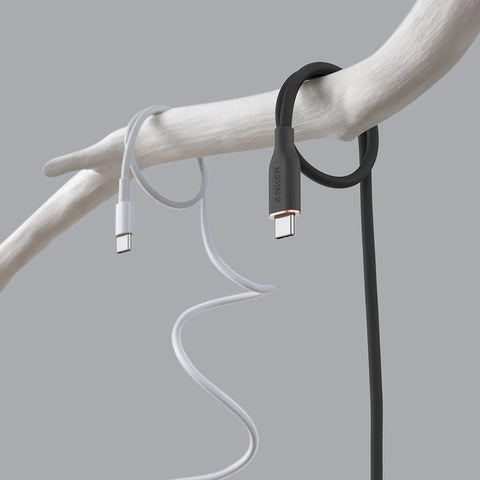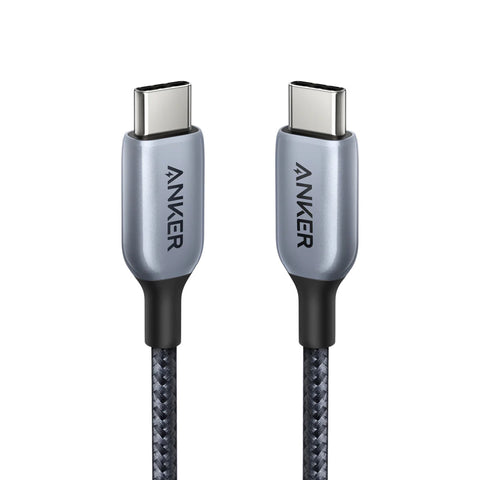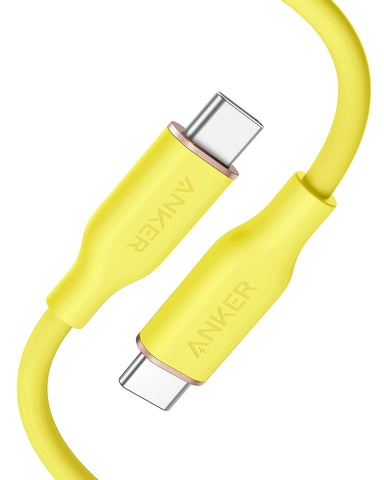
Facts 101: Are All USB-C Cables the Same for Charging?
Are all USB-C cables the same for charging? This is a modern dilemma that many consumers grapple with, considering the increasing prevalence of USB-C technology. USB-C is the latest upgrade to the widely used Universal Serial Bus (USB) standard and offers versatility, a slim design, and faster charging capabilities. In this article, we'll discuss the details of USB-C technology, examine the different types of USB-C cables, and look at the factors that affect a cable's charging capabilities. Follow us on this journey as we search for the answer to this question and gain the knowledge you need to make smart choices when buying your next USB-C cable!

What is USB-C?
USB Type-C is a type of USB (Universal Serial Bus) connector that the USB Implementers Forum developed. Its defining feature is its reversible connector design, which eliminates the frustration of plugging a USB cable incorrectly. It's a compact and versatile connector that can charge devices, transfer data, and even output display, given the right conditions and specifications.
Aside from being easier to use, USB-C is also powerful. It can carry significantly more power than traditional USB cables, enabling them to charge larger devices, like laptops. In conjunction with the USB Power Delivery standard (USB PD), USB-C can deliver up to 100 watts of power. This, combined with its high data transfer rate, makes it the connector of the future.
Different Types of USB-C Cables
Are all USB-C charging cables the same? While USB-C represents a universal connector type, the technology it carries can significantly differ. Here's a quick overview of the different types of USB-C cables:
USB-C 2.0
USB-C 2.0 is the entry-level USB-C cable supporting data transfer rate/speeds of up to 480 Mbps and a power output of up to 60W at 3A. This cable can be used for charging, syncing, and connecting USB Type-C devices to USB Type-A or other Type-C devices, offering a degree of backward compatibility. Although not the fastest option in terms of data transfer speeds, it is suitable for routine tasks like syncing mobile devices and charging laptops.
USB 3.0
Also known as USB 3.1 Gen 1, USB 3.0 cables provide data transfer rates up to 5 Gb/s. These cables offer more significant improvements in performance over USB 2.0 while maintaining compatibility with older USB devices. USB 3.0 is suitable for high-speed data transfer, making it a popular choice for external hard drives, flash drives, and other data-intensive peripherals.
USB 4
USB 4 is the latest update in the USB family, is built on the Thunderbolt protocol, and has a maximum data transfer rate of up to 40 Gbps when using certified cables. It's backward compatible with USB 3.2, USB 2.0, and also supports USB PD for faster charging. The integration of Thunderbolt makes USB 4 a powerful choice for power users who need maximum performance.
Thunderbolt 3
Thunderbolt 3 is a high-performance connectivity protocol developed by Intel that uses the USB-C connector. It boasts data transfer rates of up to 40 Gbps and support for DisplayPort 1.4, dual 4K video output at 60 Hz, or a single 5K video output at 60 Hz. Thunderbolt 3 cables can also provide up to 100W for charging devices, making it ideal for demanding applications like video editing and gaming. Note that while Thunderbolt 3 cables are compatible with USB-C devices, the devices themselves must support Thunderbolt 3 for users to reap the full benefits of this technology.
Factors That Influence a USB-C Cable’s Charging Performance
There are several factors that influence the charging performance of a USB-C cable:
Cable Gauge
The term "gauge" specifically refers to the thickness of the cable's wires. The thicker the wire (lower gauge number), the better the cable is at carrying power. A lower gauge USB-C cable can facilitate the maximum allowable amperage, thus speeding up charging times. Thinner wires (higher gauge number), on the other hand, might limit the cable's ability to deliver power efficiently, leading to slower charging rates.
Cable length
The cable length of the USB-C can also have a significant impact on its charging performance. The longer the cable, the higher the resistance, which can lead to power loss or voltage drop across the wire. Hence, charging rates can decrease as cable length increases, causing devices to charge slower. Shorter cables tend to be more efficient because they present less resistance to the flow of power.
Compatibility
Another crucial factor to consider is the compatibility of the USB-C cable with the device and the power source. The USB-C standard is a complex one, and not all cables, devices, and chargers support every feature. Some cables might just be designed for data transfer and not support fast charging; others might support fast charging but only up to a certain power limit. Ensuring your USB-C cable, device, and charger all support the same standards and power levels is essential for achieving the best charging performance.
Looking for top-notch USB-C cables? Anker has a lot to offer just for you! Take a look at these two amazing USB-C cables:
Anker 765 USB-C to USB-C Cable (140W Nylon)
The Anker 765 USB-C to USB-C Cable (140W Nylon) will let you experience the leading technology trusted by 80 million+ users. Engineered for high-speed performance with a 140W output, our cable is equipped with USB Power Delivery 3.1 to rapidly charge a vast range of devices, from smartphones to tablets to laptops. With its broad compatibility and a remarkable 35,000-bend lifespan, we've ensured enduring durability for countless USB-C devices.


Anker 765 USB-C to USB-C Cable (140W Nylon)
The Anker Advantage: Join the 80 million+ powered by our leading technology. High-Speed Ready: A maximum output of 140W and compatibility with USB Power Delivery 3.1 allows for high-speed charging to a wide range of devices including phones, tablets, and laptops. Wide Compatibility: Designed to work with virtually any USB-C device, from laptops to earbuds. Built to Last: This cable is more than ready to handle the stresses and strains of daily use thanks to a 35,000-bend lifespan. What You Get: Anker 765 USB-C to USB-C Cable (140W Nylon), welcome guide, our worry-free 24-month warranty, and friendly customer service.
Anker 643 USB-C to USB-C Cable (Flow, Silicone)
We're thrilled to present our Anker 643 USB-C to USB-C Cable (Flow, Silicone). We've taken user experience to the next level with its ultra-smooth finish, ensuring comfort with every connection. Don't let its plush feel deceive you - this cable is built to last, boasting an impressive 25,000-bend lifespan and resistance to tangles, making it ideal for on-the-go charging. Engineered to deliver efficient fast-charging, it supports up to 100W power output, ensuring compatibility with a broad spectrum of USB-C devices.


Anker 643 USB-C to USB-C Cable (Flow, Silicone)
Soft to the Touch: You’ve never felt a cable like this before. The silicone finish feels remarkably soft between your fingers as you plug the cable into your device. Super Strength: Our softest cable ever is also one of our strongest. Thanks to a 25,000-bend lifespan, this cable is more than ready to handle the stresses and strains of charging on the go. Bend It, Twist It, Flex It: Remains tangle-free even when stuffed into a bag or pocket, or wrapped around a portable charger. Fast Charging: Supports a max power output of 100W when paired with a 100W or above wall charger to power up virtually any USB-C device, including phones, tablets, and laptops. (This cable does not support media display.) What You Get: Anker 643 USB-C to USB-C Cable (Flow, Silicone) / PowerLine III Flow USB-C to USB-C Cable, silicone cable tie, welcome guide, our worry-free 18-month warranty, and friendly customer service.
Conclusion
To conclude, the question "Are all USB-C cables the same for charging?" lost ground to clear evidence that difference does exist amongst various USB-C cables and their charging capabilities. The dissimilarities stem primarily from distinctions among cable types and corresponding influencing characteristics. Determining the most suitable USB-C cable for one's specific charging needs is thus both a matter of discernment and understanding these inherent nuances.
FAQ
Here are some commonly asked questions regarding "Are all USB-C cables the same for charging?".
Do some USB-C cables only charge?
Yes, some USB-C cables are specifically designed for charging purposes only, as they lack the necessary wiring for data transfer or alternate functions. These charge-only cables are primarily used for powering devices and faster charging compared to typical USB cables.
How to choose a USB-C cable for your device?
To choose a USB-C cable for your device, consider its compatibility, use-case, and quality. Ensure the cable supports your device's charging speed or data transfer rate, is compatible with its functions (charging, data transfer, video output, etc.), and is built with high-quality materials to guarantee durability and reliability.
Can I use a USB-C cable for video output or other functions besides charging?
Yes, specific USB-C cables, such as those supporting USB-C Alt Mode or Thunderbolt 3, can be used for video output and other functions besides charging. These multi-functional cables enable data transfer, DisplayPort or HDMI output, and even docking capabilities while providing a single unified connection.














